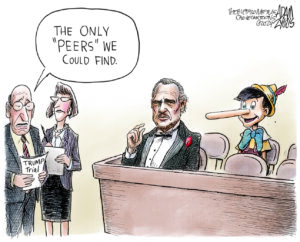The Historical Roots of the Stop Cop City Movement
Forest Defenders and activists are building on a long history of fighting policies that prioritize tourists and business interests over working-class people. Demonstrators protest Cop City in Atlanta. Photo by Atlanta DSA
Demonstrators protest Cop City in Atlanta. Photo by Atlanta DSA
On Jan. 18, 2023, a squad of local and state police officers marched into the Weelaunee Forest in southeast Atlanta, where they shot and killed a young, queer, Indigenous-Venezuelan protester named Manuel “Tortuguita” Terán. Tortuguita was one of many Atlanta forest defenders, a decentralized group of activists that has been living in the forest since 2021 to protect against its proposed destruction and replacement with “Cop City”—a massive police militarization facility complete with a “mock city” inside for police to practice their many tactics of urban warfare and repression.
The city is leasing 85 acres of the Weelaunee Forest (land originally stolen from Muscogee Creek people) to the Atlanta Police Foundation for Cop City, but it is located in a majority-Black area of DeKalb County outside of city limits, resulting in significant disenfranchisement of its residents who have few easily accessible official channels to register their dissent. While Cop City would impact everyone in Atlanta and across the country, it will have especially disastrous ramifications for nearby residents, who will lose the benefit of the forest’s flood prevention and cooling impacts. Indeed, this is land that the city referred to in 2017 as one of the “four lungs” of Atlanta and slated for incorporation into a broader set of park land—a promise the city broke just four years later.
While the political assassination of Tortuguita thrust the multi-year struggle against Cop City into the national spotlight, Atlanta organizers have been working against the project for years. The proposal first went public in early 2021. It was quickly opposed by a broad coalition that included environmental justice and human rights organizations, abolitionists, groups working against gentrification, clergy, neighborhood associations near the proposed site, and more. Community members consistently advocated and attended public meetings throughout the summer of 2021. When it came time for the final City Council vote on the Cop City legislation, the council meeting lasted two days due to over 17 hours of public comment, in which the vast majority of commenters opposed the project.
Despite the massive local opposition to Cop City, a combination of state and corporate forces worked hand in hand for years to push for its creation.
Meanwhile, it was residents from northeast Atlanta, a disproportionately white and wealthy area of the city, who spoke in favor of Cop City. As one Black resident from southwest Atlanta summarized poignantly, “It doesn’t appear as if the police protect us. They protect the north side. But you want them to train over here . . . why is that?”
Despite the massive local opposition to Cop City, a combination of state and corporate forces worked hand in hand for years to push for its creation. The private nonprofit Atlanta Police Foundation (APF) championed the vision for Cop City, working on the plans for it since at least 2017. APF is backed by a mix of some of Atlanta’s most prominent corporations, including Delta, UPS, Home Depot, Wells Fargo, and Coca-Cola, as well as major foundations like the Georgia Power Foundation and the Woodruff Foundation, whose founder was the president of Coca-Cola from 1923-85. Many of the same corporations’ leaders sit on the Atlanta Committee for Progress (ACP), a public-private partnership made up of corporate, state, nonprofit, and university leaders that has vocally supported Cop City—including the 2021 commitment from their then-Board Chair Alex Taylor to lead the fundraising campaign for $30 million in private funds, half of the anticipated $60 million total cost to build the facility. Taylor is also the CEO of Cox Enterprises, the corporation that owns Atlanta’s main media outlet, the Atlanta Journal-Constitution—resulting in an endless stream of pro-Cop City op-eds and editorials since the project was announced, with the paper often failing to disclose the relationship between AJC and Cox.
In other words, Cop City is a fundamentally anti-democratic project driven by a mix of powerful actors, while Atlanta’s residents, particularly those closest to the proposed site, have been utterly ignored.
This is far from the first time that Atlanta has prioritized the wishes of its ruling class over the community; it’s a defining feature of Atlanta governance. While the fight to Stop Cop City is a more recent struggle against the Atlanta ruling class’ orientation toward its most vulnerable residents, it should be understood within a much longer trend of state, corporate, and nonprofit forces banding together to shape the city in their interests and at the expense of Black and working-class residents. This pattern showed up perhaps most vividly in the transformation of the city that occurred in the leadup to the 1996 Olympics.
To attract the Olympics and the supposed increase in revenue and reputation that the Games would bring, Atlanta’s political and economic leadership worked to physically and ideologically reshape Atlanta as a world-class city—a mission that predated but intensified during the city’s preparation for the Olympics. While the APF and ACP lead the push for Cop City today, the private nonprofit Atlanta Committee on the Olympic Games (ACOG) and groups like the Central Atlanta Progress (a nonprofit representing Atlanta’s business interests) championed the vision and city transformation for the Olympics.
Upon being selected for the 1996 Olympics, the city’s leaders prepared Atlanta for the games with displacement, destruction, and redevelopment. In 1995, the city destroyed Techwood Homes, the U.S.’s oldest federally subsidized public housing project, to clear the way for the Olympic village that would house athletes and media. Just south of Techwood Homes, the Techwood Park district—an “economically and culturally vibrant location” home to over 10% of the city’s shelter capacity that was painted as a “slum” by the city’s corporate forces—was transformed by ACOG into the fenced-in Centennial Olympic Park. Several other neighborhoods were cut up or destroyed in the service of the Olympics, including Atlanta’s Summerhill neighborhood, which was replaced by the Centennial Olympic Stadium and an array of townhouses that were unaffordable for prior residents.
The city also made significant policy changes and other infrastructural investments that would facilitate displacement, often through criminalization. In 1991, the Atlanta City Council passed new city laws hyper-criminalizing homelessness—laws that, according to historian Maurice Hobson, “were so ambiguous that they could be enforced against undesirables at the discretion of authorities.” In 1995, the city opened the Atlanta City Detention Center downtown with an approximate 1,000-bed capacity, which state forces used to clear mostly Black homeless people from the streets and hold them over the weekend when tourists flooded the city. Hauntingly, the new jail was referred to by one city official as “the first Olympic project completed on time.” Organizers are still fighting to close this jail.
The city displaced roughly 30,000 people from their homes between 1990 and 1996 and illegally arrested over 9,000 homeless people between 1995 and 1996. At the time, some activists even uncovered the Atlanta Police Department’s use of pre-printed tickets with categories filled out for “African American,” “Male,” and “Homeless.”
While state and corporate actors were the key drivers of the Olympic transformation, nonprofits also aided directly in the displacement, lending resources, involvement, and cover to state violence. For example, through a partnership between the city and the nonprofit organization Travelers Aid, homeless individuals were given one-way tickets out of town and were reportedly required to sign pledges not to return. Just as state and corporate entities partnered with nonprofits during the Olympic displacement, today, the Atlanta Police Foundation is partnering with the National Center for Civil and Human Rights to offer “human rights” training to the Atlanta Police Department—a partnership touted during the leadup to the City Council vote on Cop City.
Atlanta’s quest to frame itself as a world-class city that is welcoming to tourists and big business will continue to go hand in hand with increased policing and displacement.
In the two and a half decades since the Games, Atlanta’s hostility toward Black and working-class residents has only intensified. Atlanta’s leadership continually poured vast sums of public money into private projects while the city has gentrified rapidly and low-income residents have been pushed further out. In 2017, the City closed Peachtree and Pine, the city’s largest homeless shelter. Ownership of the building has since been transferred to Central Atlanta Progress, the group that once helped to champion Atlanta’s Olympic transformation. As Anita Beaty, then-executive director of the Metro Atlanta Task Force for the Homeless, noted, “the [Olympic] juggernaut was a dry run, a dress rehearsal for the developers and the elites to take over the city, to take over the planning, housing construction—to eliminate public housing.” These words have proven to be tragically true.
Today, many of the same forces that once worked to reshape the city continue to build on the city’s Olympic legacy to attract other large events, most prominently the 2024 Democratic National Convention (DNC) and the 2026 FIFA World Cup. In the city’s bid to attract the DNC—an event that has been compared to the Olympics—Atlanta’s leadership has touted its hotel capacity, planned improvements to stadium infrastructure, and the city’s ability to call on at least 27 other police and fire departments in nearby areas.
While these events are certainly not the only reason that city leadership has worked so hard to create Cop City, they are nonetheless directly related. Atlanta’s quest to frame itself as a world-class city that is welcoming to tourists and big business will continue to go hand in hand with increased policing and displacement. At a recent City Council meeting, for example, the Atlanta chief of police stated that he was seeking to recruit over 400 additional police officers by the time of the 2026 World Cup. Likewise, despite committing in 2019 to closing the city jail built in preparation for the Olympics, in 2022, city leadership instead voted to re-open and fill the jail with 700 people from the county jail.
In other words, when it comes to the displacement, destruction, and violence associated with the vastly unpopular Cop City project, Atlanta has been here before. State and corporate forces continue to run the city in the service of real estate capital, tech jobs, tourism, and upper-class white communities—and at the expense of Black and working-class residents. Carceral expansion, real estate development, and major events continue to mutually reinforce one another.
But just as there were once protests against the violence of the Olympic project in Atlanta, so too are people resisting state violence today. The movement to Stop Cop City is only becoming more powerful as more people join every day and take action even in the midst of massive and likely unconstitutional state repression. While Atlanta’s posture toward its most vulnerable has held steady for decades, the Stop Cop City movement is here to stay. The movement has the potential not just to stop the destruction of the forest and the construction of a deadly police playground, but also to begin reversing the transformation that has for so long held our communities ransom. When we fight, we win.
Your support matters…Independent journalism is under threat and overshadowed by heavily funded mainstream media.
You can help level the playing field. Become a member.
Your tax-deductible contribution keeps us digging beneath the headlines to give you thought-provoking, investigative reporting and analysis that unearths what's really happening- without compromise.
Give today to support our courageous, independent journalists.









You need to be a supporter to comment.
There are currently no responses to this article.
Be the first to respond.